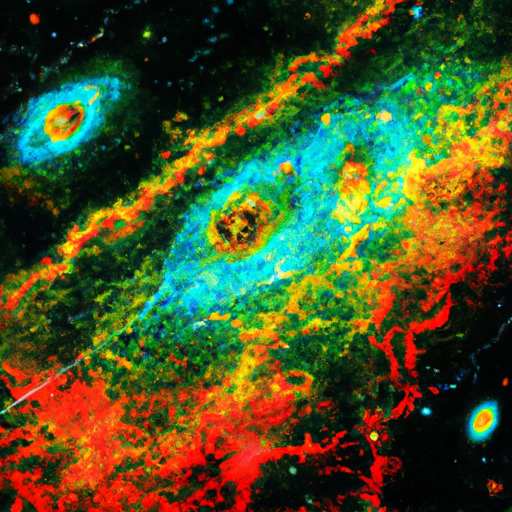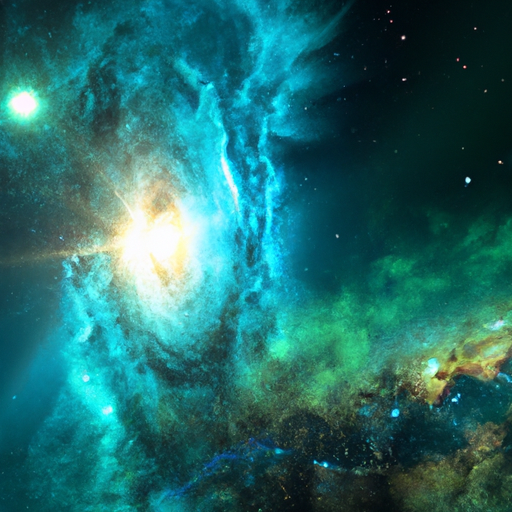In the vast field of contemporary cosmology, one element has emerged as a crucial piece in unraveling the mysteries of the universe: the Cosmic Microwave Background (CMB). This extraordinary radiation, which permeates the entire cosmos, holds valuable information about the early stages of our universe’s evolution. Utilizing advanced technology and groundbreaking research, scientists are harnessing the power of the CMB to gain insights into the age, composition, and structure of the universe, sparking new revelations that challenge our understanding of space and time. Embark on a journey through the realm of contemporary cosmology as we explore the pivotal role of the Cosmic Microwave Background and its profound implications for our understanding of the cosmos.
What is Cosmic Microwave Background?
Cosmic Microwave Background (CMB) is the faint radiation that permeates through the entire universe. It is essentially the afterglow of the Big Bang, the event that marked the birth of our universe. CMB is a form of electromagnetic radiation that is present in the microwave region of the electromagnetic spectrum, with an average temperature of approximately 2.7 Kelvin (-270.45 degrees Celsius). It is considered one of the most important phenomena in cosmology as it provides valuable insights into the origins and evolution of the universe.
The Discovery of Cosmic Microwave Background (CMB)
Penzias and Wilson’s Discovery
The discovery of CMB can be attributed to Arno Penzias and Robert Wilson, two astronomers working at the Bell Telephone Laboratories in New Jersey in the 1960s. While conducting experiments with a large horn antenna that was originally designed for satellite communication, they noticed a persistent background noise that was interfering with their observations. This noise was present in all directions and seemed to be independent of their antenna’s position. Initially, they thought the noise was due to bird droppings inside the antenna.
After thorough investigations, Penzias and Wilson realized that the noise they were observing was not of terrestrial origin but of cosmic significance. They had accidentally stumbled upon the cosmic microwave background radiation, a groundbreaking discovery that earned them the Nobel Prize in Physics in 1978. This accidental discovery opened up a new field of study in cosmology, providing crucial evidence for the Big Bang theory.
Confirmation by COBE Satellite
The Cosmic Background Explorer (COBE) satellite, launched by NASA in 1989, played a pivotal role in confirming Penzias and Wilson’s discovery. The satellite was equipped with specialized instruments that could measure the temperature and intensity variations of the CMB with unprecedented precision. The data collected by COBE further solidified the existence and properties of CMB, providing detailed insights into its temperature distribution across the sky.

Understanding the Cosmic Microwave Background
Properties of CMB Radiation
CMB radiation possesses several unique properties that make it a powerful tool for understanding the universe. Firstly, it is isotropic, meaning it is nearly uniform in all directions, indicating that it originated from a single event, namely the Big Bang. Secondly, CMB radiation is highly homogeneous, with temperature variations at the level of one part in 100,000. These temperature fluctuations are of great interest to cosmologists as they provide valuable information about the density fluctuations in the early universe from which galaxies and other cosmic structures eventually formed.
Temperature Variations in the CMB
One of the most fascinating aspects of CMB is its temperature variations across the sky. These temperature fluctuations, known as anisotropies, are incredibly small and require sophisticated instruments to measure accurately. By examining these variations, scientists can gain valuable insights into the structure and composition of the universe. The study of CMB anisotropy has provided substantial evidence for the current understanding of the universe’s evolution and has played a significant role in supporting the Big Bang theory.
CMB and the Big Bang Theory
Supporting Evidence for the Big Bang
The discovery and study of CMB have provided powerful evidence in support of the Big Bang theory. According to this theory, the universe originated from an incredibly dense and hot state approximately 13.8 billion years ago. As the universe expanded, it cooled down, leaving behind the cosmic microwave background radiation that we observe today. The uniformity and isotropy of the CMB strongly align with the predictions of the Big Bang theory, lending significant credibility to this model of the universe’s origins.
The Relationship between CMB and Big Bang
CMB radiation serves as a direct link to the early stages of the universe’s evolution. By studying the properties of CMB, scientists can infer important aspects of the early universe, such as its temperature, density, and composition. The temperature fluctuations in the CMB provide information about the density variations in the early universe, which eventually led to the formation of galaxies, stars, and other cosmic structures. Therefore, CMB acts as a time capsule, allowing us to peer back in time and understand the conditions that prevailed during the universe’s infancy.

Measuring the Cosmic Microwave Background
Satellite-based Observations
Satellites have played a crucial role in measuring and studying CMB radiation. Instruments aboard satellites like COBE, WMAP (Wilkinson Microwave Anisotropy Probe), and Planck have provided valuable data on the temperature fluctuations, intensity distribution, and polarization properties of CMB. These space missions have significantly advanced our understanding of CMB, allowing cosmologists to test and refine theories regarding the early universe’s behavior and the subsequent evolution of cosmic structures.
Ground-based Observations
In addition to satellite-based observations, ground-based experiments have also contributed immensely to the study of CMB. Ground-based telescopes, equipped with specialized instruments, are capable of capturing high-resolution images of the CMB and studying its properties in finer detail. These observations are essential for cross-validation of satellite data and for uncovering new insights into the physics of CMB radiation. Ground-based observations are also crucial for conducting experiments aimed at detecting specific features of CMB, such as B-mode polarization, which could shed light on cosmic inflation and the nature of dark matter.
The Anisotropy of the Cosmic Microwave Background
Small-scale Anisotropy
CMB anisotropy can be categorized into two scales: small-scale and large-scale. Small-scale anisotropy refers to temperature fluctuations at smaller angular scales. These fluctuations are primarily caused by the gravitational interactions of matter and radiation in the early universe. By studying the small-scale anisotropy of CMB, scientists can gather information about the density variations, primordial perturbations, and the acoustic oscillations that occurred during the early stages of the universe’s expansion.
Large-scale Anisotropy
Large-scale anisotropy, also known as the cosmic variance, refers to temperature fluctuations at larger angular scales. These fluctuations arise from the distribution of matter on the largest cosmic scales. Analyzing the large-scale anisotropy of CMB helps scientists understand the overall structure of the universe, including the distribution of matter, dark matter, and dark energy. This information is crucial for refining models and theories related to the formation and evolution of the universe.
The Cosmic Microwave Background and Inflation Theory
Introduction to Inflation Theory
Inflation theory is a concept that postulates a rapid expansion of the universe during the first moments after the Big Bang. This theory provides an explanation for the observed uniformity and isotropy of CMB radiation, as well as the formation of large cosmic structures. According to inflationary cosmology, the rapid expansion smoothed out the irregularities in the early universe, resulting in the nearly uniform distribution of CMB radiation that we observe today.
The Role of CMB in Validating Inflation Theory
CMB plays a crucial role in validating and refining inflationary cosmology. By studying the temperature fluctuations in the CMB, scientists can test various inflationary models and determine their compatibility with observational data. The specific patterns and statistical properties of the temperature variations in the CMB provide valuable insights into the underlying physical processes during the inflationary epoch. Therefore, continued measurements and analysis of CMB are vital for furthering our understanding of inflation theory and its implications for the early universe.
Cosmic Microwave Background and Structure Formation
Seeding Structure Formation
One of the significant implications of CMB radiation is its role in seeding the formation of cosmic structures, such as galaxies and galaxy clusters. The slight temperature fluctuations observed in CMB represent density variations in the early universe. Over time, these density fluctuations acted as “seeds” for the gravitational collapse and formation of structures on a cosmic scale. By analyzing the CMB anisotropy and its correlation with large-scale structure, scientists can gain valuable insights into the processes that gave rise to the vast cosmic web we observe today.
Baryonic Acoustic Oscillations
CMB radiation also provides evidence for a phenomenon known as baryonic acoustic oscillations (BAOs). These oscillations are imprinted in the early universe due to the interactions between photons and baryonic matter. The analysis of the temperature fluctuations in the CMB, particularly their characteristic scale and distribution, provides important constraints on the properties of dark matter, dark energy, and the expansion history of the universe. By studying BAOs, scientists can gain insights into the nature of cosmic acceleration and the composition of the universe.
Improving CMB Measurements
Future Space Missions
The field of CMB research continues to evolve, with several exciting missions planned for the future. Missions like LiteBIRD (Lite (Light) satellite for the studies of B-mode polarization and Inflation from Cosmic Background Radiation Detection), PICO (Probe of Inflation and Cosmic Origins), and CMB-S4 (Cosmic Microwave Background Stage 4) aim to enhance our measurements of CMB anisotropy and polarization with unprecedented precision. These missions will allow cosmologists to further investigate inflationary models, study the properties of dark matter and dark energy, and explore the physics of the early universe in greater detail.
Advances in Ground-Based Observatories
Alongside space missions, ground-based observatories are also undergoing advancements to improve CMB measurements. The development of sophisticated instruments, such as large-scale arrays of antennas, bolometers, and specialized receivers, enables researchers to capture higher-resolution images of the CMB. Additionally, ground-based experiments allow for long-term observations and continuous monitoring of the CMB, providing valuable data for cross-validation with satellite missions and enhancing our understanding of the universe.
Cosmological Parameters from CMB
Determining the Age of the Universe
The study of CMB radiation provides valuable insights into the age of the universe and its expansion rate. By analyzing the CMB data, scientists can extract cosmological parameters, such as the Hubble constant and the amount of matter and energy in the universe. These parameters help determine the age of the universe and its overall composition. The remarkable agreement between observations of CMB and other cosmological probes, such as supernovae and galaxy clustering, reinforces the accuracy and reliability of our current understanding of the universe’s age.
Measuring the Proportion of Dark Matter and Dark Energy
CMB radiation also allows scientists to probe the proportions of dark matter and dark energy in the universe. Dark matter, which does not interact with light, plays a crucial role in the formation of cosmic structures. Dark energy, on the other hand, is responsible for the accelerated expansion of the universe. By studying the CMB anisotropy, scientists can constrain the amount of dark matter and dark energy, providing crucial insights into their nature and contributions to the dynamics of the universe.
In conclusion, Cosmic Microwave Background (CMB) has revolutionized our understanding of the universe. Its discovery and subsequent study have provided valuable insights into the early universe, the Big Bang theory, the formation of cosmic structures, and the nature of dark matter and dark energy. By analyzing CMB anisotropy and refining cosmological models, scientists continue to unravel the mysteries of our universe’s origins and evolution. Future missions and advancements in technology hold the promise of further enhancing our understanding of CMB and its role in contemporary cosmology.